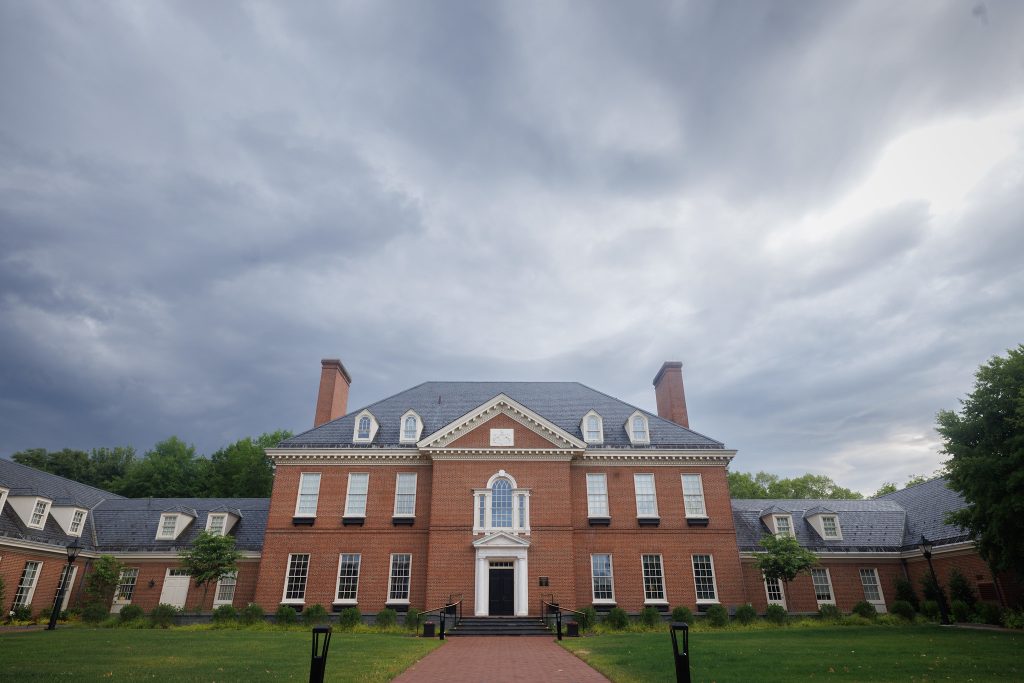by Angela Couloumbis of Spotlight PA
Photo courtesy of Commonwealth Media Services
Spotlight PA is an independent, nonpartisan, and nonprofit newsroom producing investigative and public-service journalism that holds power to account and drives positive change in Pennsylvania. Sign up for our free newsletters.
Bel Air, Beverly Hills, and the Bahamas. New York, Greenwich, and London.
The de la Torre Design Studio in New York City has, as its website boasts, “been there, designed that,” beautifying the interiors of penthouses, estates, and even yachts in those and other tony locales.
Now, the design firm has been quietly hired for another interior makeover: Gov. Josh Shapiro’s official state residence in Harrisburg.
Dubbed the “residence reimagining project” by a staffer for the Democratic governor, the work will focus on bringing in new pieces of furniture, art, and other items to the public areas of the historic mansion along the Susquehanna River, according to information obtained by Spotlight PA through a public records request.
Beyond that, little is known about the scale, scope, or even the price tag for the redesign. Despite the involvement of Shapiro’s aides in the project, no one will say who is managing it, raising money for it, or exactly who is paying for it.
The contract itself with the de la Torre Design Studio was signed by Team Pennsylvania, a Harrisburg-based nonprofit organization whose mission is to bring together public officials and private-sector leaders to collaborate on bolstering the state’s economy. Its investors include corporations from Pennsylvania’s largest industries.
The group does not publicly disclose its donors — nonprofits are generally not required to under federal tax law. When asked by Spotlight PA to release its donor names, at least for the residence redesign, it declined.
The result is public officials using private money from undisclosed donors to carry out work on a state-owned property. The lack of transparency leaves taxpayers in the dark about who is underwriting the project, including whether any of those donors have financial interests in state policy.
The arrangement again raises questions about Shapiro’s ties to Team PA, and whether expenses paid on his or his administration’s behalf by the nonprofit should be disclosed on his annual statements of financial interest. As Spotlight PA has reported, the organization last year paid for Shapiro to attend the Super Bowl and other sporting events, and his administration has said it plans to continue accepting tickets from the group.
“The public has a right to know how their government is operating and how government officials are benefitting from things like private funding,” said John P. Pelissero, director of government ethics at the Markkula Center for Applied Ethics at Santa Clara University. “Everything that is going on could be quite above board … but this absence of transparency creates the appearance that there is something to hide, and that has the potential to erode public trust.”
In an interview last month, Team PA President and CEO Abby Smith said that in addition to running many programs and projects, the organization also acts as a “fiscal agent,” or manager, for various funds and committees associated with the governor’s office. Examples include the advisory commissions on Latino affairs, women, and LGBTQ affairs, among others.
One of those pots of money supports preservation efforts at the governor’s residence, and the de la Torre Design Studio will be paid from that fund, Smith said. She said the redesign is funded by private donors interested in maintaining the historic house and that the preservation fund predates the Shapiro administration by more than a decade to the administration of Republican Gov. Tom Corbett.
But she did not disclose who oversees the fund, who raises money for it, or who makes decisions on how those dollars are spent.
“Since we only serve as the fiscal agent for the Preservation Fund, there aren’t any details we can provide — we’re not working on the project, we’re just managing the administrative aspects (i.e. contracts),” Smith said in an email.
Shapiro spokesperson Manuel Bonder also did not respond to questions about who oversees the fund.
In an emailed statement, he said the redesign will focus on public spaces and will not involve any of the private spaces used by the Shapiro family. Over the years, the residence has hosted events, including dinners, Easter egg hunts, Trick-or-Treat nights, and winter holiday tours.
Bonder also said the fund has been used by previous governors, but provided no detail about how the money was used by them.
“The Governor’s Residence is a historic Commonwealth-owned landmark that regularly hosts public tours, open houses, and community events for people from all across Pennsylvania — but after years without attention to its important role representing Pennsylvania history, work is needed to update the public areas of the Residence and teach visitors the story of our Commonwealth,” Bonder wrote.
He added: “The Governor and the First Lady are proud to frequently host Pennsylvanians from all walks of life, and they look forward to continuing to work to ensure the Residence adequately represents Pennsylvania’s proud and diverse history.”

The house on the Susquehanna
The governor’s three-story, Georgian-style mansion sits on a more than three-acre property along the banks of the Susquehanna River, about a mile from downtown Harrisburg. The nearly 29,000-square-foot house is surrounded by meticulously landscaped lawns and gardens, including one that features historically significant plants, shrubs, and flowers native to Pennsylvania, according to the residence’s official website.
The residence also houses a collection of historical art that includes paintings on loan from the Philadelphia Museum of Art, the State Museum of Pennsylvania, and the Carnegie Museum of Art.
Eight governors and their families have called it home since it was built in 1968, the website says — although they have used it differently. Former Republican Gov. Tom Ridge lived there full-time with his wife and children. Shapiro’s immediate predecessor, Democrat Tom Wolf, chose to remain in his then-home in York County and used the residence primarily for meetings and events.
The residence is a state-owned historic property overseen by Pennsylvania’s Department of General Services. The agency pays for maintenance and other expenses at the home, which in 2022 underwent a $2.6 million renovation to its front courtyard to make it both more environmentally friendly and more easily accessible to people with mobility problems.
State dollars also cover the cost of 17 staffers at the residence, including chefs, butlers, and housekeeping and maintenance staff, as well as an executive director who oversees day-to-day operations, according to the Department of General Services.
Taxpayers also pay for certain expenses for governors and their families. LNP | Lancaster Online last year found through public records requests that public money had paid more than $1.8 million for Shapiro and his family to live in the residence in the first 11 months of the governor’s tenure (Shapiro took office in January 2023). That amount included more than $92,000 to update the decor and the appliances inside the residence, and to replace dishware and other kitchen items.
The contract between Team PA and the de la Torre Design Studio is different.
Unlike contracts between state agencies and private contractors, this one is not publicly accessible through Pennsylvania’s website for state contracts over $5,000.
Spotlight PA learned about the agreement through a broader public records request for emails, texts, and other communications between Shapiro’s office and Team PA. The residence reimagining contract was an attachment in a chain of emails between a Shapiro staffer and Team PA’s Smith about the project.
The agreement, dated Jan. 16 of this year, does not provide specifics about the interior design firm’s work. It says that de la Torre will submit concept designs that will include “preliminary furniture plans, floor plan alterations (with no structural modifications), types of materials, color schemes, preliminary finishes, furniture, furnishings and elevations of interior decoration of all areas.”
There is no overall price tag noted, but the contract states de la Torre charges for the cost of most items plus procurement fees. According to the contract, there is a 35% fee for “all furnishings, furniture, art and decorative art, hardware, window treatments, ceiling treatments, floor treatments, and lighting fixtures, and related expenses such as moving.”
Custom-designed pieces also include hourly billing fees ranging from $125 to $300 per hour.
In an email, Smith said the residence preservation fund had $324,352 at the end of last year — down from $455,564 at the end of 2022 — but could not say how much of that money will be spent on the residence reimagining project.
Team PA provided information about how much money was in the fund each year for the past five years but said it could not specify how much money has been raised and spent each year for the past five years.
“I don’t have the staff capacity to dig up receipts/how much was raised in each of those years,” Smith said in an email to Spotlight PA.
Neither Smith nor Bonder responded to questions about who is directly responsible for fundraising and managing the preservation fund despite repeated requests for that information.
In his statement, Bonder did say that raising private dollars for maintaining executive residences is not unusual. Indeed, Colorado, Ohio, Oklahoma, and other states have nonprofit foundations dedicated to preserving their governors’ mansions.
But those foundations are organized and registered as separate nonprofit organizations, and file annual tax statements that publicly list their revenues, assets, expenditures, board members, staff, and other key information about their activities; they are not required to disclose their donors.
Team PA also files such annual tax disclosures, known as Form 990. However, the organization is not required to list every fund it manages, so it is not publicly known how much money flows in or out of the preservation fund each year.
A public-private partnership
Team PA was formed nearly 30 years ago by then-Gov. Ridge as a unique partnership between the public and private sectors with a very specific aim: to bolster Pennsylvania’s economy and inspire entrepreneurship.
The organization is co-chaired by the governor in office, as well as a private sector representative. Its website says that it brings together leaders from government and private industry to collaborate on “transformative economic opportunities” in agriculture, energy, and manufacturing, with plans to expand those partnerships to include biotechnology and innovation technology.
Its board of directors includes legislators, administration officials, university presidents, union leaders, and business leaders from the energy, insurance, farming, and other sectors, according to its most recent annual report. Its investors hail from similar sectors.
As Spotlight PA has reported, the nonprofit also holds state contracts. Last year, it was awarded $1.8 million in taxpayer money from three new contracts: $1.2 million to study hydrogen technology and the remainder for creating an economic development plan for Pennsylvania.
Team PA separately acts as the fiscal steward to several other funds and commissions associated with the governor’s office, though this role is a small part of its overall operation, according to Smith.
Aside from the preservation fund, Team PA also collects private donations for a fund called the Pennsylvania Growth Partnership. That fund is meant to “spur economic growth for the Commonwealth by increasing the visibility of the Governor and Pennsylvania and positioning Pennsylvania’s Governor as the leader of business attraction and retention,” according to Team PA’s website.
Like with the preservation fund, Team PA does not make public the names of donors to the Pennsylvania Growth Partnership.
“We follow all of the laws that are required for nonprofit disclosure,” Smith said when asked about making the organization’s donors public.
Pelissero of the Markkula Center for Applied Ethics said the governor’s office has “nothing to lose” by being candid about the private donations.
“It’s one of those optic issues,” he said.
He added: “The public has a right to know whether the funding and the sources of that funding are designed to benefit the public interest or some private interest.”
BEFORE YOU GO… If you learned something from this article, pay it forward and contribute to Spotlight PA at spotlightpa.org/donate. Spotlight PA is funded by foundations and readers like you who are committed to accountability journalism that gets results.




